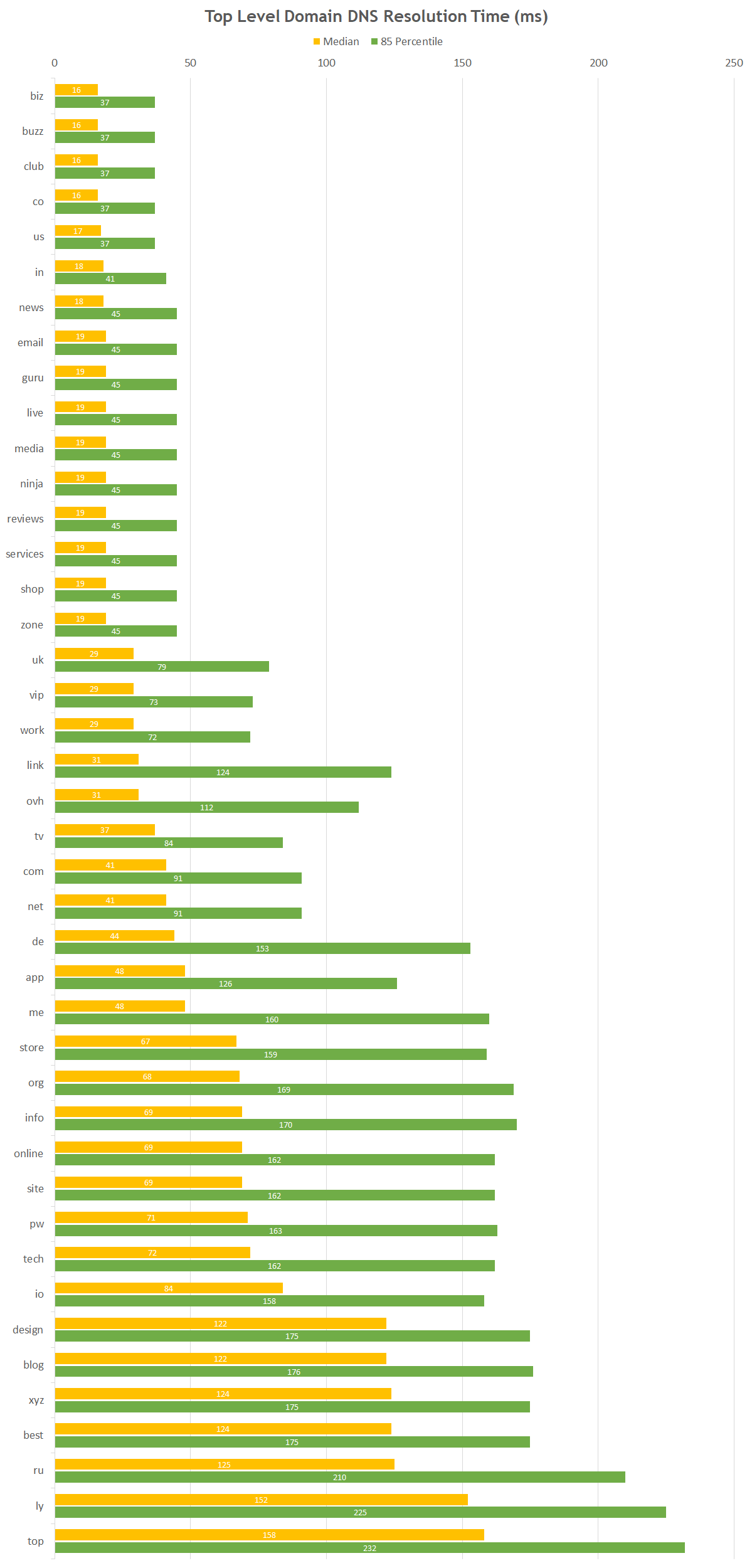Comparative analysis of the famous Top Level Domains (.com, .fr…)
The crux of the war for high-visibility websites is the download time. As a natural referencing factor admitted by Google, this download time can be significantly impacted during DNS resolution. If it is necessary to rely on a first-class DNS infrastructure, the choice of the extension associated with a domain name is important. Indeed, not all registries perform equally well in terms of DNS, not to say that some have disappointing performance. The offer in terms of TLDs (nearly 1400) has greatly increased since ICANN’s New Extensions Program. Analysis to follow.
A quick look at DNS resolution time and its impact on load time
Resolving a domain such as nameshield.net follows several steps before you can contact the content server. The DNS resolver contacts the root DNS servers (.), then the DNS servers of the registry of the extension concerned (.net) in order to obtain the list of DNS servers responsible for the domain, and finally these DNS servers to obtain the requested response. The response obtained is certainly cached by the DNS resolver (generally managed by the Internet Service Provider), but this will not always be the case depending on the popularity of your domain.
This means that if the DNS for the top level domain (.net) is slow, it may actually delay DNS resolution for the domain itself and, in the very unlikely worst case scenario, even cause a breakdown. There’s not much you can do about this, apart from choosing the right TLD.
Comparative Analysis
Bunny CDN, a Slovenian content delivery player, conducted the following surprising analysis. Relying on their global network, they monitored DNS performance worldwide from more than 50 sites and networks.
For each TLD, their system chose a random name server published for each top-level domains and queried a random domain name. The results were grouped by region and the data recorded every 10 seconds.
Results
They tested 42 of the most popular top-level domains and then aggregated the results into a global median average and an 85-percentile aggregation (the 15% slowest responses were not taken into account). These tests were conducted only from their network, so a more complete study would certainly be worthwhile, but they provide a good overview.

The results were quite surprising
The most surprising domains are .info and .org, which have shown really poor performance, especially in the 85 percentile range, despite their seniority and the millions of domains registered. It seems that 4 of the 6 names servers function extremely poorly, which explains the poor results.
The .net and .com have been very slightly slower than expected in Europe and North America, but otherwise offer excellent and stable performance in all regions, visible in the global median. .net and .com have much larger networks, but remain a very interesting choice for absolute maximum performance.
Less expected is the performance of the .co, .biz and .in TLDs, well ahead of the others.
Some new domains (.online, .top, .blog…), which are attractive from a marketing point of view and growing strongly, show disappointing performances…
… on the other hand, very good surprises for .live, .email, .news, managed by Donuts Inc or .club and .buzz managed by Neustar Inc, with, however, a very important decrease in performance in regions outside Europe and North America, which further aggravates the problem.
42 of the most popular TLDs among the 1400+ available have been tested. Without drawing any definitive conclusions, we can assume that many may not work much better.
Conclusion
Do you need to revolutionize the management of your domain name portfolio and the choice of TLDs for your most visible websites? Should you switch everything to .biz or .co immediately to increase performance?
Certainly not. First of all, DNS responses are heavily cached, especially for very popular websites, resolvers may not need to reach many top-level names servers. Then, the choice of a domain name is primarily driven by marketing imperatives (brand, geographical area, name availability) that are often far more impactful than the additional 50 milliseconds of loading time for the first page to load.
However, if you are trying to compress absolutely every last bit of performance and ensure high reliability in a system where every last millisecond counts, then you may want to think twice before choosing your domain. The differences aren’t huge, but if you’re aiming for that one-second loading time, things can add up to 200 ms in some cases.
Choosing the right TLD based on DNS performance is indeed a good thing, but probably not a cause for too much concern.
